FIAT FULLBACK 2017 Owner handbook (in English)
Manufacturer: FIAT, Model Year: 2017, Model line: FULLBACK, Model: FIAT FULLBACK 2017Pages: 312, PDF Size: 12.31 MB
Page 271 of 312
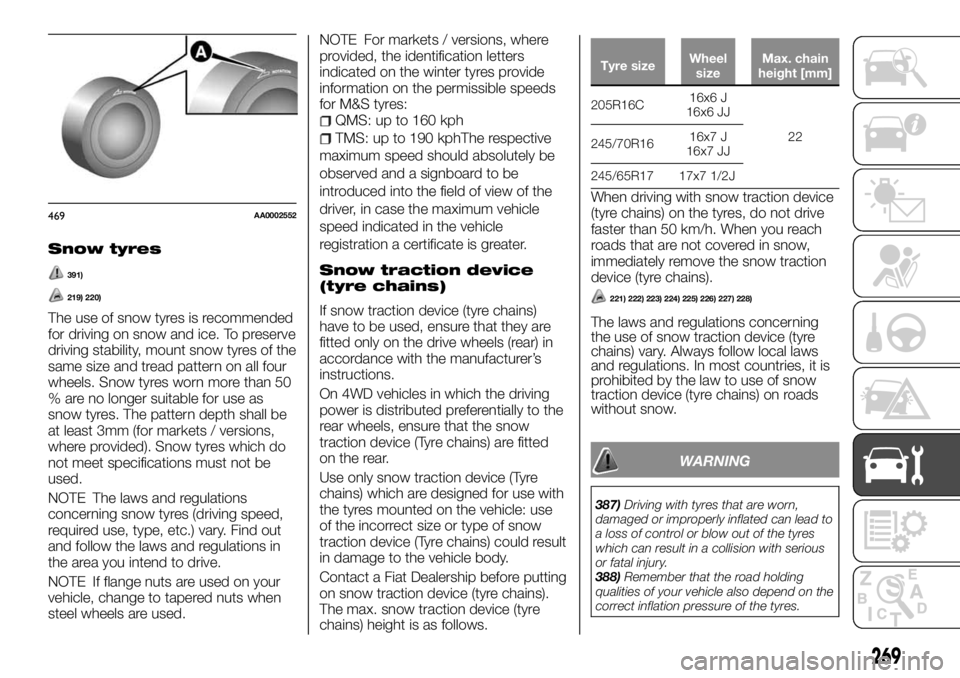
Snow tyres
391)
219) 220)
The use of snow tyres is recommended
for driving on snow and ice. To preserve
driving stability, mount snow tyres of the
same size and tread pattern on all four
wheels. Snow tyres worn more than 50
% are no longer suitable for use as
snow tyres. The pattern depth shall be
at least 3mm (for markets / versions,
where provided). Snow tyres which do
not meet specifications must not be
used.
NOTE The laws and regulations
concerning snow tyres (driving speed,
required use, type, etc.) vary. Find out
and follow the laws and regulations in
the area you intend to drive.
NOTE If flange nuts are used on your
vehicle, change to tapered nuts when
steel wheels are used.NOTE For markets / versions, where
provided, the identification letters
indicated on the winter tyres provide
information on the permissible speeds
for M&S tyres:
QMS: up to 160 kph
TMS: up to 190 kphThe respective
maximum speed should absolutely be
observed and a signboard to be
introduced into the field of view of the
driver, in case the maximum vehicle
speed indicated in the vehicle
registration a certificate is greater.
Snow traction device
(tyre chains)
If snow traction device (tyre chains)
have to be used, ensure that they are
fitted only on the drive wheels (rear) in
accordance with the manufacturer’s
instructions.
On 4WD vehicles in which the driving
power is distributed preferentially to the
rear wheels, ensure that the snow
traction device (Tyre chains) are fitted
on the rear.
Use only snow traction device (Tyre
chains) which are designed for use with
the tyres mounted on the vehicle: use
of the incorrect size or type of snow
traction device (Tyre chains) could result
in damage to the vehicle body.
Contact a Fiat Dealership before putting
on snow traction device (tyre chains).
The max. snow traction device (tyre
chains) height is as follows.
Tyre sizeWheel
sizeMax. chain
height [mm]
205R16C16x6 J
16x6 JJ
22
245/70R1616x7 J
16x7 JJ
245/65R17 17x7 1/2J
When driving with snow traction device
(tyre chains) on the tyres, do not drive
faster than 50 km/h. When you reach
roads that are not covered in snow,
immediately remove the snow traction
device (tyre chains).
221) 222) 223) 224) 225) 226) 227) 228)
The laws and regulations concerning
the use of snow traction device (tyre
chains) vary. Always follow local laws
and regulations. In most countries, it is
prohibited by the law to use of snow
traction device (tyre chains) on roads
without snow.
WARNING
387)Driving with tyres that are worn,
damaged or improperly inflated can lead to
a loss of control or blow out of the tyres
which can result in a collision with serious
or fatal injury.
388)Remember that the road holding
qualities of your vehicle also depend on the
correct inflation pressure of the tyres.
469AA0002552
269
Page 272 of 312
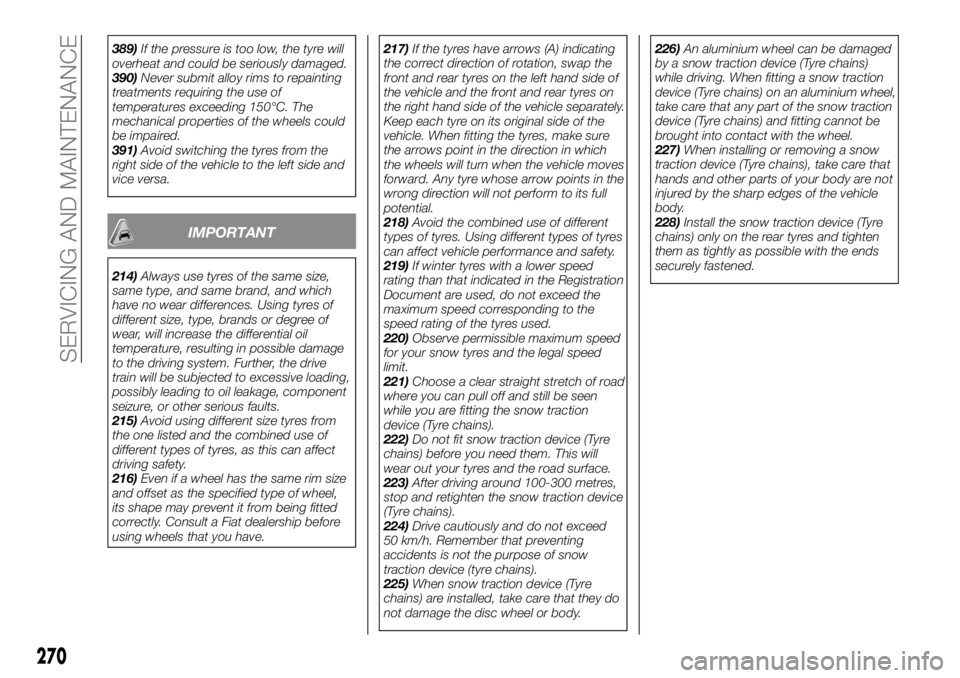
389)If the pressure is too low, the tyre will
overheat and could be seriously damaged.
390)Never submit alloy rims to repainting
treatments requiring the use of
temperatures exceeding 150°C. The
mechanical properties of the wheels could
be impaired.
391)Avoid switching the tyres from the
right side of the vehicle to the left side and
vice versa.
IMPORTANT
214)Always use tyres of the same size,
same type, and same brand, and which
have no wear differences. Using tyres of
different size, type, brands or degree of
wear, will increase the differential oil
temperature, resulting in possible damage
to the driving system. Further, the drive
train will be subjected to excessive loading,
possibly leading to oil leakage, component
seizure, or other serious faults.
215)Avoid using different size tyres from
the one listed and the combined use of
different types of tyres, as this can affect
driving safety.
216)Even if a wheel has the same rim size
and offset as the specified type of wheel,
its shape may prevent it from being fitted
correctly. Consult a Fiat dealership before
using wheels that you have.217)If the tyres have arrows (A) indicating
the correct direction of rotation, swap the
front and rear tyres on the left hand side of
the vehicle and the front and rear tyres on
the right hand side of the vehicle separately.
Keep each tyre on its original side of the
vehicle. When fitting the tyres, make sure
the arrows point in the direction in which
the wheels will turn when the vehicle moves
forward. Any tyre whose arrow points in the
wrong direction will not perform to its full
potential.
218)Avoid the combined use of different
types of tyres. Using different types of tyres
can affect vehicle performance and safety.
219)If winter tyres with a lower speed
rating than that indicated in the Registration
Document are used, do not exceed the
maximum speed corresponding to the
speed rating of the tyres used.
220)Observe permissible maximum speed
for your snow tyres and the legal speed
limit.
221)Choose a clear straight stretch of road
where you can pull off and still be seen
while you are fitting the snow traction
device (Tyre chains).
222)Do not fit snow traction device (Tyre
chains) before you need them. This will
wear out your tyres and the road surface.
223)After driving around 100-300 metres,
stop and retighten the snow traction device
(Tyre chains).
224)Drive cautiously and do not exceed
50 km/h. Remember that preventing
accidents is not the purpose of snow
traction device (tyre chains).
225)When snow traction device (Tyre
chains) are installed, take care that they do
not damage the disc wheel or body.226)An aluminium wheel can be damaged
by a snow traction device (Tyre chains)
while driving. When fitting a snow traction
device (Tyre chains) on an aluminium wheel,
take care that any part of the snow traction
device (Tyre chains) and fitting cannot be
brought into contact with the wheel.
227)When installing or removing a snow
traction device (Tyre chains), take care that
hands and other parts of your body are not
injured by the sharp edges of the vehicle
body.
228)Install the snow traction device (Tyre
chains) only on the rear tyres and tighten
them as tightly as possible with the ends
securely fastened.
270
SERVICING AND MAINTENANCE
Page 273 of 312
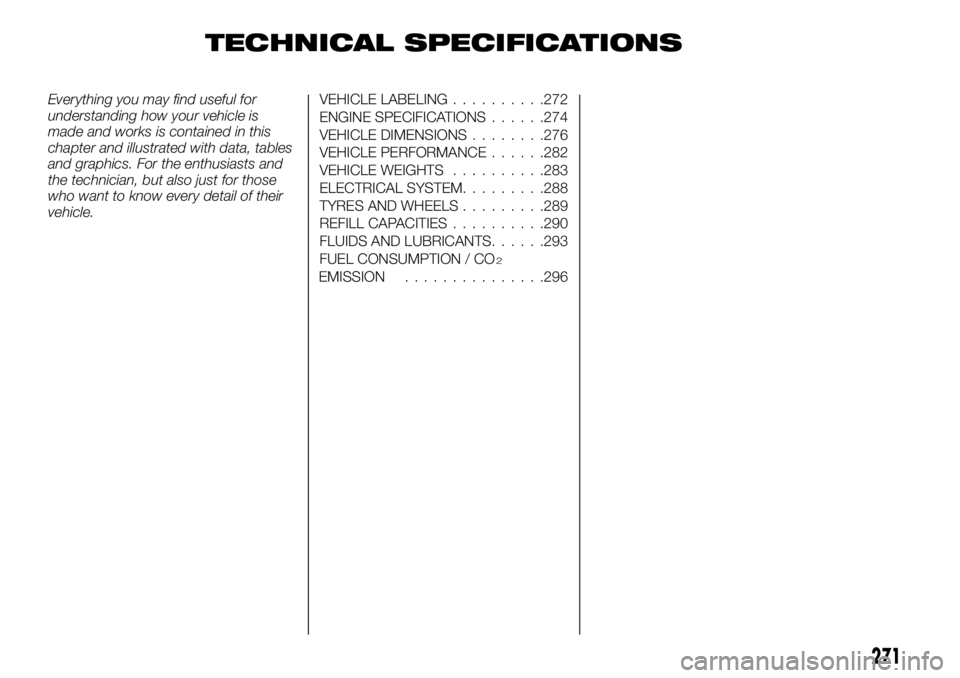
TECHNICAL SPECIFICATIONS
Everything you may find useful for
understanding how your vehicle is
made and works is contained in this
chapter and illustrated with data, tables
and graphics. For the enthusiasts and
the technician, but also just for those
who want to know every detail of their
vehicle.VEHICLE LABELING..........272
ENGINE SPECIFICATIONS......274
VEHICLE DIMENSIONS........276
VEHICLE PERFORMANCE......282
VEHICLE WEIGHTS..........283
ELECTRICAL SYSTEM.........288
TYRES AND WHEELS.........289
REFILL CAPACITIES..........290
FLUIDS AND LUBRICANTS......293
FUEL CONSUMPTION / CO
2
EMISSION...............296
271
Page 274 of 312
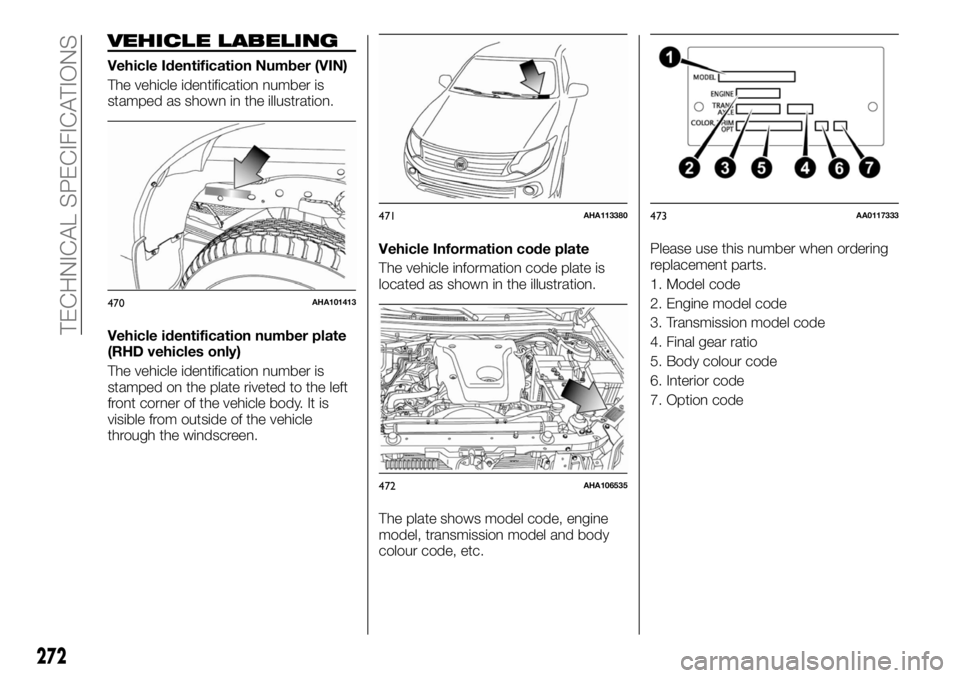
VEHICLE LABELING
Vehicle Identification Number (VIN)
The vehicle identification number is
stamped as shown in the illustration.
Vehicle identification number plate
(RHD vehicles only)
The vehicle identification number is
stamped on the plate riveted to the left
front corner of the vehicle body. It is
visible from outside of the vehicle
through the windscreen.Vehicle Information code plate
The vehicle information code plate is
located as shown in the illustration.
The plate shows model code, engine
model, transmission model and body
colour code, etc.Please use this number when ordering
replacement parts.
1. Model code
2. Engine model code
3. Transmission model code
4. Final gear ratio
5. Body colour code
6. Interior code
7. Option code
470AHA101413
471AHA113380
472AHA106535
473AA0117333
272
TECHNICAL SPECIFICATIONS
Page 275 of 312
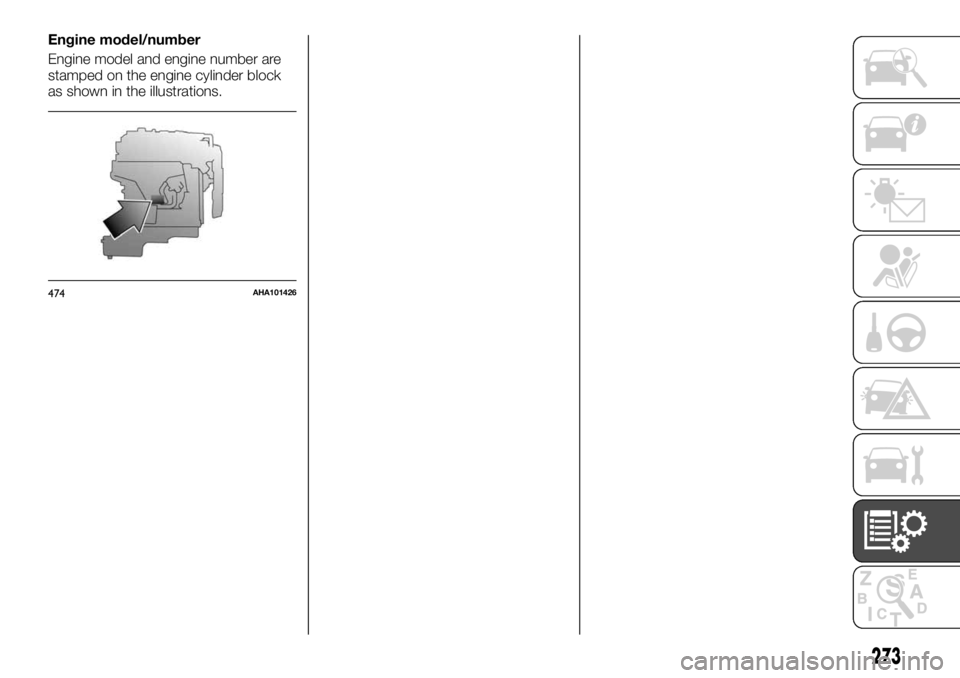
Engine model/number
Engine model and engine number are
stamped on the engine cylinder block
as shown in the illustrations.
474AHA101426
273
Page 276 of 312
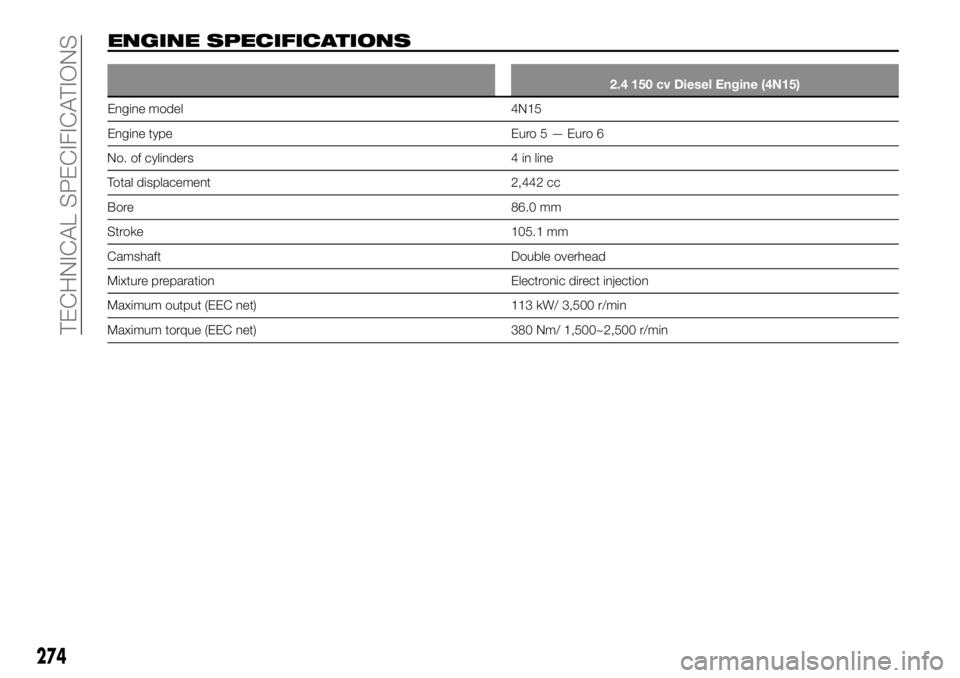
ENGINE SPECIFICATIONS
2.4 150 cv Diesel Engine (4N15)
Engine model 4N15
Engine type Euro5—Euro6
No. of cylinders 4 in line
Total displacement 2,442 cc
Bore 86.0 mm
Stroke 105.1 mm
Camshaft Double overhead
Mixture preparation Electronic direct injection
Maximum output (EEC net) 113 kW/ 3,500 r/min
Maximum torque (EEC net) 380 Nm/ 1,500~2,500 r/min
274
TECHNICAL SPECIFICATIONS
Page 277 of 312
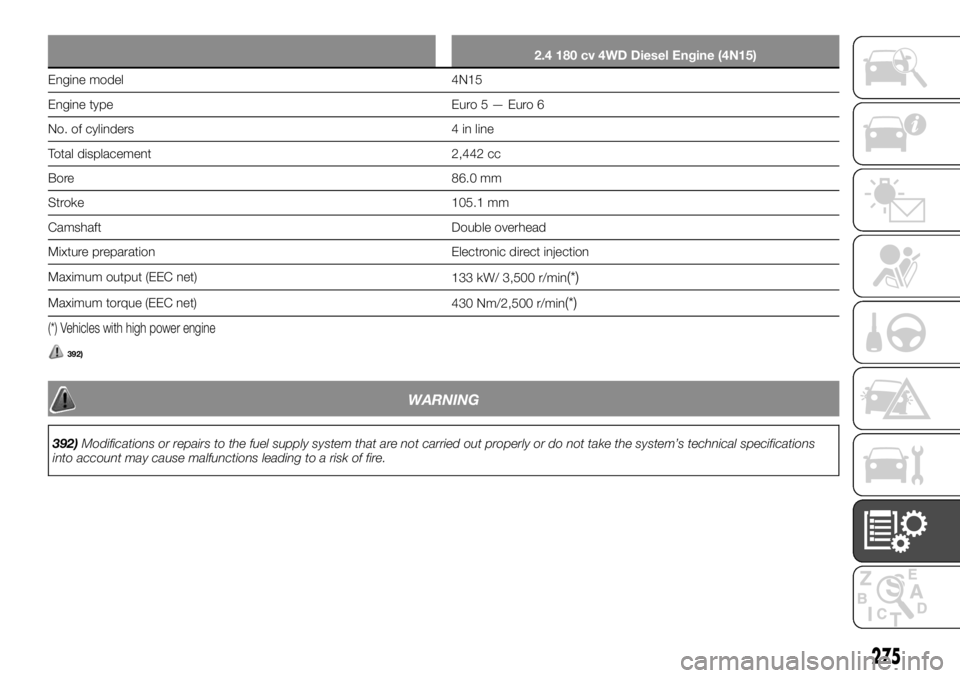
2.4 180 cv 4WD Diesel Engine (4N15)
Engine model 4N15
Engine type Euro5—Euro6
No. of cylinders 4 in line
Total displacement 2,442 cc
Bore 86.0 mm
Stroke 105.1 mm
Camshaft Double overhead
Mixture preparation Electronic direct injection
Maximum output (EEC net)
133 kW/ 3,500 r/min
(*)
Maximum torque (EEC net)
430 Nm/2,500 r/min(*)
(*) Vehicles with high power engine
392)
WARNING
392)Modifications or repairs to the fuel supply system that are not carried out properly or do not take the system’s technical specifications
into account may cause malfunctions leading to a risk of fire.
275
Page 278 of 312
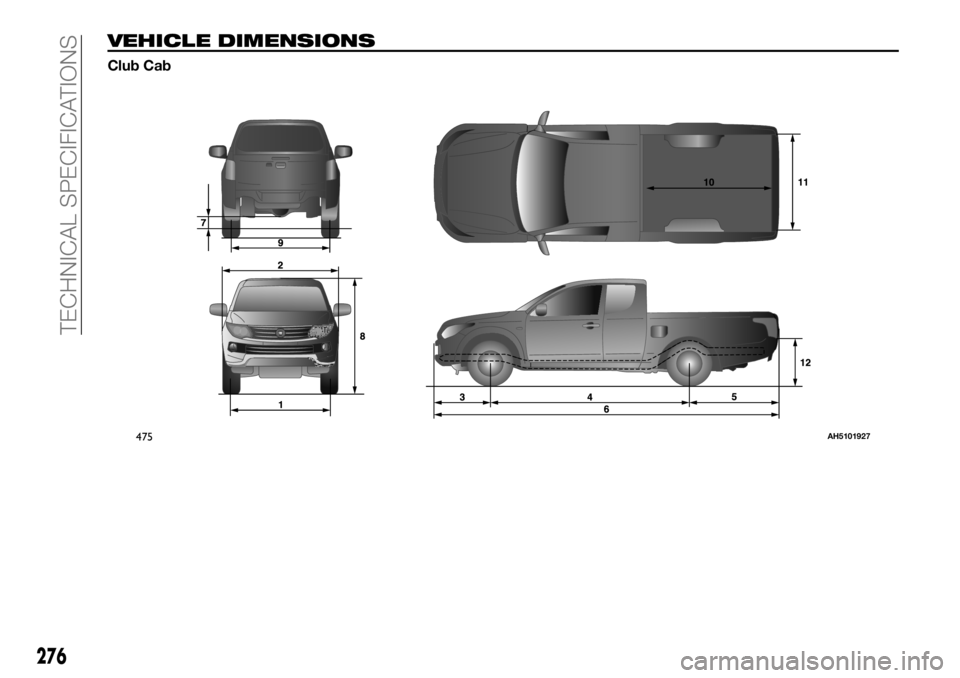
VEHICLE DIMENSIONS
Club Cab
475AH5101927
276
TECHNICAL SPECIFICATIONS
Page 279 of 312
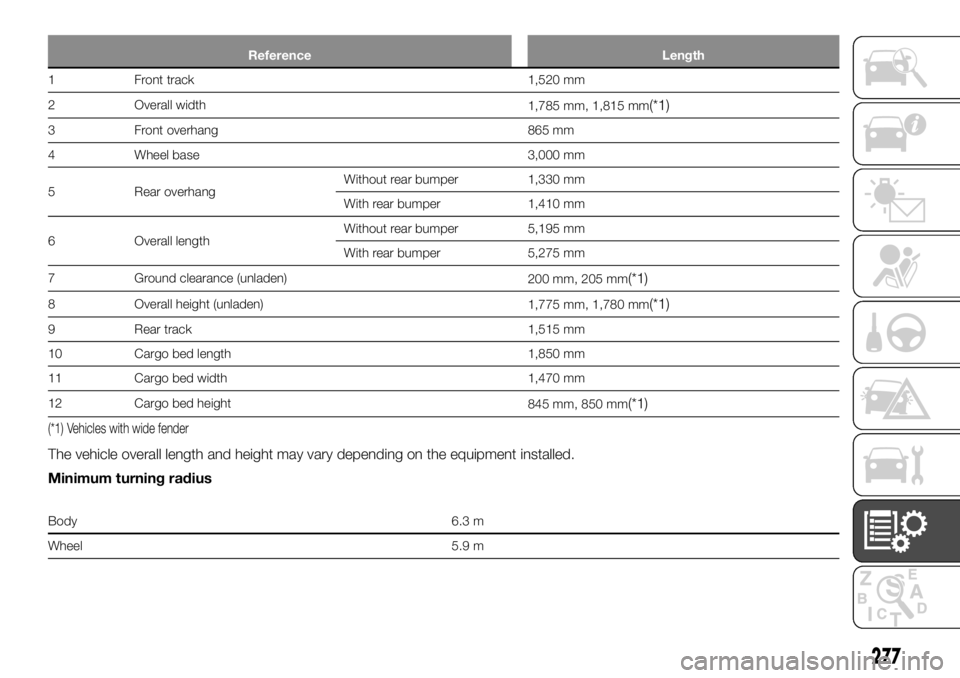
Reference Length
1 Front track 1,520 mm
2 Overall width
1,785 mm, 1,815 mm
(*1)
3 Front overhang 865 mm
4 Wheel base 3,000 mm
5 Rear overhangWithout rear bumper 1,330 mm
With rear bumper 1,410 mm
6 Overall lengthWithout rear bumper 5,195 mm
With rear bumper 5,275 mm
7 Ground clearance (unladen)
200 mm, 205 mm
(*1)
8 Overall height (unladen)
1,775 mm, 1,780 mm(*1)
9 Rear track 1,515 mm
10 Cargo bed length 1,850 mm
11 Cargo bed width 1,470 mm
12 Cargo bed height
845 mm, 850 mm
(*1)
(*1) Vehicles with wide fender
The vehicle overall length and height may vary depending on the equipment installed.
Minimum turning radius
Body 6.3 m
Wheel 5.9 m
277
Page 280 of 312
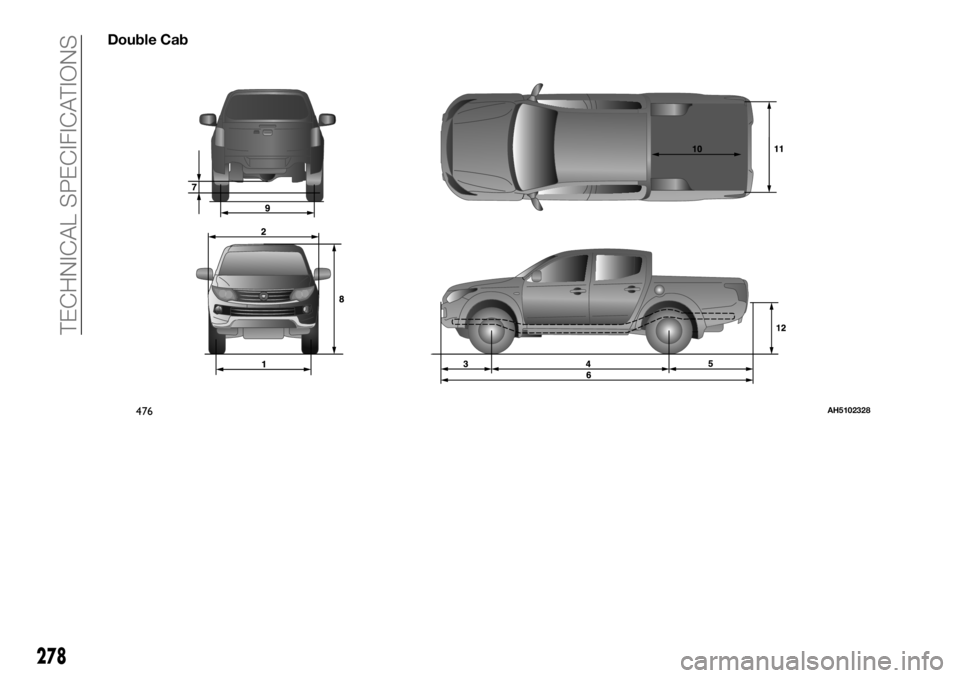
Double Cab
476AH5102328
278
TECHNICAL SPECIFICATIONS